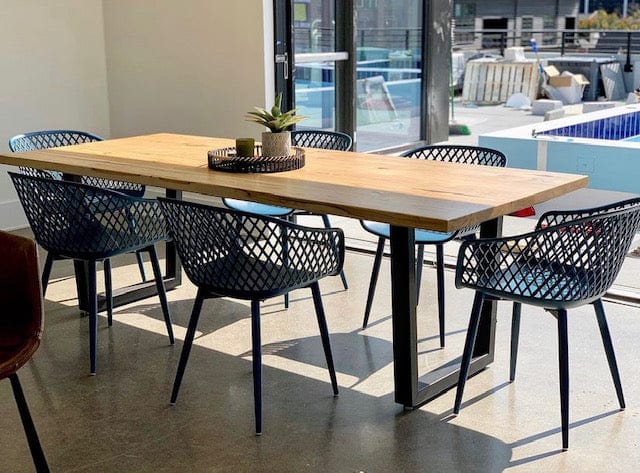Discover the most effective Materials for Dining Room Table Legs for Every Style
Discover the most effective Materials for Dining Room Table Legs for Every Style
Blog Article
A Detailed Check Out Table Leg Styles: Locating the Suitable Match
Selecting the appropriate eating table leg style is crucial for both aesthetic appeal and functional performance. Conventional 4 legs supply ageless beauty and stability, while the stand base offers increased legroom and a contemporary look. For those with bigger tables, trestle legs make sure durable support, whereas barrette legs introduce a mid-century modern-day ambiance with their minimalist layout. The x-shaped legs blend modern style with boosted security. Each of these choices brings unique advantages, making the choice greater than just an issue of choice. Discover even more to uncover which style flawlessly complements your eating room and way of living.
Conventional 4 Legs
Among the various kinds of eating table leg designs, the traditional four-leg style remains a timeless choice for many houses. 4 legs supply well balanced support, guaranteeing the table remains stable and qualified of bearing significant weight (dining room table legs).
From an aesthetic viewpoint, the typical four-leg layout can be quickly adapted to various indoor styles. Whether crafted from wood, steel, or a mix of products, these legs can be elaborately carved, sleek and minimalistic, or anything in between. Their convenience enables them to match both rustic and contemporary setups effortlessly.
Additionally, the straightforward framework of the four-leg layout assists in simplicity of activity and positioning within a room. Unlike even more complex bases, this design lessens obstructions, giving adequate legroom for diners. In recap, the conventional four-leg table leg design marries withstanding beauty with sensible performance, making it a sharp selection for those looking for both form and function in their eating furniture.
Stand Base
Typically commemorated for its sophisticated and space-efficient design, the stand base is a distinguished option to the traditional four-leg setup in eating table leg styles. This distinct base generally includes a single main column supporting the table top, which can differ in form, from ornately carved timber to sleek, contemporary steel. One of the primary benefits of the stand base is its ability to make best use of legroom and seating versatility. Without edge legs, restaurants are paid for better freedom of motion, making it an excellent choice for round and oval tables that advertise more intimate and comprehensive events.
Furthermore, the stand base's central support can handle considerable weight, permitting for the use of heavier tabletops, such as marble or thick wood. This strength paired with its aesthetic versatility makes the pedestal base a popular selection in both conventional and contemporary indoor settings. It can effortlessly integrate with different layout styles, from traditional style to minimalist modernity. The main column itself offers a canvas for elaborate styles and imaginative expressions, adding an element of aesthetic passion below the table. In recap, the pedestal base integrates functionality snappy, making it a refined and useful alternative for diverse eating atmospheres.
Trestle Legs
Trestle legs offer a robust and timeless structure for eating tables, defined by their horizontal cross-bracing and strong support beam of lights. Stemming from middle ages times, this style has progressed yet preserved its necessary structure, making it a perennial fave in both traditional and modern setups. The main trestle beam of light, often supported by 2 or more upright blog posts, supplies remarkable security, allowing for larger table lengths without the demand for added legs.
A considerable benefit of trestle leg tables is the adequate legroom they supply. Unlike tables with four corner legs, the absence of blockages at internet the table's edges offers unblocked room for chairs and diners, improving convenience and access. This makes trestle tables perfect for suiting larger events, whether in a dining area or a banquet hall.
The aesthetic versatility of trestle legs is notable. Readily available in a range of products such as wood, steel, and composite, they can be ended up to enhance a large variety of indoor designs. From rustic farmhouse to sleek contemporary layouts, trestle legs can be personalized to fit specific preferences. Their long-lasting charm and functional benefits make trestle legs an engaging choice for those seeking both design and practicality in their table.
Hairpin Legs

The appeal of barrette legs hinges on their simpleness and versatility - dining room table legs. Readily available in a series of materials, consisting of steel and brass, they can be completed in various colors to complement various read this indoor designs. Whether coupled with a rustic wooden table top or a contemporary glass surface, hairpin legs easily mix performance with a touch of vintage beauty
Resilience is an additional notable attribute of barrette legs. Despite their fragile appearance, these legs are crafted to birth significant weight, making certain the eating table continues to be steady and safe. Furthermore, they are fairly easy to mount, making them a popular option for do it yourself fanatics and specialist furnishings makers alike.
X-Shaped Legs

Built from products such as steel, wood, or a combination of both, X-shaped legs can be tailored to match numerous style choices. Steel legs typically offer a sleek and industrial feeling, ideal for loft-style houses and here contemporary eating areas. On the various other hand, wooden X-shaped legs provide a warmer, a lot more rustic allure, appropriate for farmhouse or diverse insides. The flexibility in products permits home owners to customize their table to better fit their overall style plan.
Additionally, the design behind X-shaped legs ensures even weight distribution, reducing the risk of wobbling and enhancing toughness. This makes them especially fit for bigger table that call for added assistance. Basically, X-shaped legs mix practical engineering with contemporary looks, making them a classic selection for varied dining atmospheres.
Conclusion
A detailed understanding of dining table leg designs exposes the distinct attributes and advantages of each design. Trestle legs make certain robust assistance for bigger tables, and hairpin legs present a mid-century modern visual.
Report this page